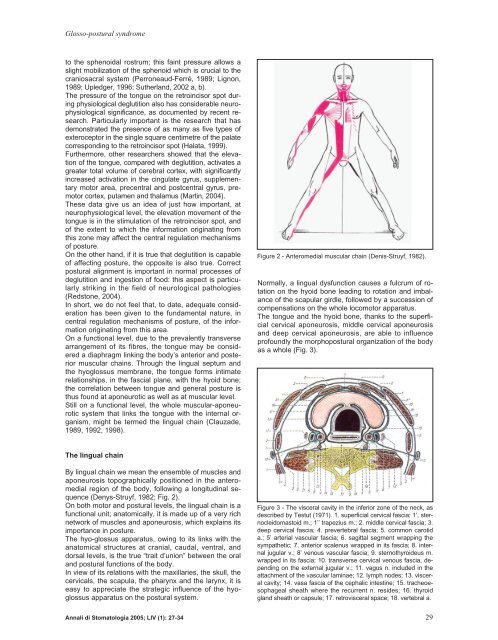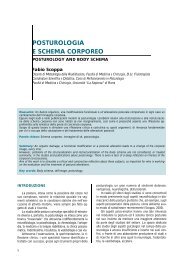Glosso-postural syndrome
Glosso-postural syndrome
Glosso-postural syndrome
You also want an ePaper? Increase the reach of your titles
YUMPU automatically turns print PDFs into web optimized ePapers that Google loves.
<strong>Glosso</strong>-<strong>postural</strong> <strong>syndrome</strong><br />
to the sphenoidal rostrum; this faint pressure allows a<br />
slight mobilization of the sphenoid which is crucial to the<br />
craniosacral system (Perroneaud-Ferré, 1989; Lignon,<br />
1989; Upledger, 1996; Sutherland, 2002 a, b).<br />
The pressure of the tongue on the retroincisor spot during<br />
physiological deglutition also has considerable neurophysiological<br />
significance, as documented by recent research.<br />
Particularly important is the research that has<br />
demonstrated the presence of as many as five types of<br />
exteroceptor in the single square centimetre of the palate<br />
corresponding to the retroincisor spot (Halata, 1999).<br />
Furthermore, other researchers showed that the elevation<br />
of the tongue, compared with deglutition, activates a<br />
greater total volume of cerebral cortex, with significantly<br />
increased activation in the cingulate gyrus, supplementary<br />
motor area, precentral and postcentral gyrus, premotor<br />
cortex, putamen and thalamus (Martin, 2004).<br />
These data give us an idea of just how important, at<br />
neurophysiological level, the elevation movement of the<br />
tongue is in the stimulation of the retroincisor spot, and<br />
of the extent to which the information originating from<br />
this zone may affect the central regulation mechanisms<br />
of posture.<br />
On the other hand, if it is true that deglutition is capable<br />
of affecting posture, the opposite is also true. Correct<br />
<strong>postural</strong> alignment is important in normal processes of<br />
deglutition and ingestion of food: this aspect is particularly<br />
striking in the field of neurological pathologies<br />
(Redstone, 2004).<br />
In short, we do not feel that, to date, adequate consideration<br />
has been given to the fundamental nature, in<br />
central regulation mechanisms of posture, of the information<br />
originating from this area.<br />
On a functional level, due to the prevalently transverse<br />
arrangement of its fibres, the tongue may be considered<br />
a diaphragm linking the body’s anterior and posterior<br />
muscular chains. Through the lingual septum and<br />
the hyoglossus membrane, the tongue forms intimate<br />
relationships, in the fascial plane, with the hyoid bone;<br />
the correlation between tongue and general posture is<br />
thus found at aponeurotic as well as at muscular level.<br />
Still on a functional level, the whole muscular-aponeurotic<br />
system that links the tongue with the internal organism,<br />
might be termed the lingual chain (Clauzade,<br />
1989, 1992, 1998).<br />
The lingual chain<br />
By lingual chain we mean the ensemble of muscles and<br />
aponeurosis topographically positioned in the anteromedial<br />
region of the body, following a longitudinal sequence<br />
(Denys-Struyf, 1982; Fig. 2).<br />
On both motor and <strong>postural</strong> levels, the lingual chain is a<br />
functional unit; anatomically, it is made up of a very rich<br />
network of muscles and aponeurosis, which explains its<br />
importance in posture.<br />
The hyo-glossus apparatus, owing to its links with the<br />
anatomical structures at cranial, caudal, ventral, and<br />
dorsal levels, is the true “trait d’union” between the oral<br />
and <strong>postural</strong> functions of the body.<br />
In view of its relations with the maxillaries, the skull, the<br />
cervicals, the scapula, the pharynx and the larynx, it is<br />
easy to appreciate the strategic influence of the hyoglossus<br />
apparatus on the <strong>postural</strong> system.<br />
Figure 2 - Anteromedial muscular chain (Denis-Struyf, 1982).<br />
Normally, a lingual dysfunction causes a fulcrum of rotation<br />
on the hyoid bone leading to rotation and imbalance<br />
of the scapular girdle, followed by a succession of<br />
compensations on the whole locomotor apparatus.<br />
The tongue and the hyoid bone, thanks to the superficial<br />
cervical aponeurosis, middle cervical aponeurosis<br />
and deep cervical aponeurosis, are able to influence<br />
profoundly the morpho<strong>postural</strong> organization of the body<br />
as a whole (Fig. 3).<br />
Figure 3 - The visceral cavity in the inferior zone of the neck, as<br />
described by Testut (1971). 1. superficial cervical fascia; 1’, sternocleidomastoid<br />
m.; 1’’ trapezius m.; 2. middle cervical fascia; 3.<br />
deep cervical fascia; 4. prevertebral fascia; 5. common carotid<br />
a.; 5’ arterial vascular fascia; 6. sagittal segment wrapping the<br />
sympathetic; 7. anterior scalenus wrapped in its fascia; 8. internal<br />
jugular v.; 8’ venous vascular fascia; 9. sternothyroideus m.<br />
wrapped in its fascia; 10. transverse cervical venous fascia, depending<br />
on the external jugular v.; 11. vagus n. included in the<br />
attachment of the vascular laminae; 12. lymph nodes; 13. visceral<br />
cavity; 14. vasa fascia of the cephalic intestine; 15. tracheoesophageal<br />
sheath where the recurrent n. resides; 16. thyroid<br />
gland sheath or capsule; 17. retrovisceral space; 18. vertebral a.<br />
Annali di Stomatologia 2005; LIV (1): 27-34 29



